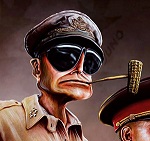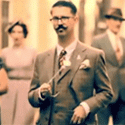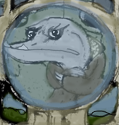|
What would happen if that gun overheated? Would the plane's engine just explode?
|
|
|
|

|
| # ? May 2, 2024 09:06 |
|
Mans posted:What were their characteristics? I know the Germans tended to make deep, angled trenches and tended to make them as comfortable as possible, since they knew their soldiers would tend to hang around them or a while. Hell, the bunkers in some of those things were wired for electricity. Edit: The characteristic British WW1 Western Front infantry experience is living in a hole scratched clumsily out of the poisoned earth while everything rots around you. The characteristic German WW1 Western Front infantry experience is getting shelled for days, wondering what would kill you first, a direct hit or asphyxiation once the entryway to your underground cell collapses. HEY GUNS fucked around with this message at 19:33 on Nov 16, 2013 |
|
|
|
Godholio posted:Was that a short-lived device or did it carry on? I've never noticed it before. Every Bf-109 after 1941, nearly every Soviet plane, most of the French planes, and of course the P-39 all used cannons that fired through the prop hub. I'd guess that would be around half of the total number of fighters built for the war.
|
|
|
|
I want to clarify I specifically didn't realize the BF-109 had it...I knew it was a thing (because of the P-39).
|
|
|
|
SlothfulCobra posted:What would happen if that gun overheated? Would the plane's engine just explode? I'm sure this would be impossible. If the gun ever could become that hot (and since engines run hot already, it would need to be really hot to make a difference), its mechanism would sooner jam itself. But airplane autocannons also had very limited amount of ammunition, like a second or two's worth, so I don't think they'd heat up nearly enough even if the pilot shot all his ammo in a single burst.
|
|
|
|
Nenonen posted:But airplane autocannons also had very limited amount of ammunition, like a second or two's worth, so I don't think they'd heat up nearly enough even if the pilot shot all his ammo in a single burst. Sorry if this seems like a nitpick, but the typical fighters with nose cannons had quite a bit more than that, from between six and twelve seconds. The Yaks had 8 and 9 seconds, the Ta 152H-1 had 9 seconds, for example. I think you may be being misled by the P-39, I don't have figures on that but I know that autocannon was a beast with clunky ammo.
|
|
|
|
Nenonen posted:Another even kookier approach used in French and German interwar designs was to place a gun within the engine, to fire through a hollow propeller hub. Here's Bf-109 with two synchronized 13mm mg's and a 20mm autocannon firing through the propeller axis. That doesn't really seem so kooky to me. On that diagram are two machine guns that are successfully synchronised anyways. I wonder if it's a quirk of an autocannon? I can't think on an example of a plane with a synchronised one of those.
|
|
|
|
Slim Jim Pickens posted:That doesn't really seem so kooky to me. On that diagram are two machine guns that are successfully synchronised anyways. There were a handful of examples. The La-5/7 and the late model Yak-3s and -9s usually synched two or three 20mm cannons mounted on top of the engine and firing through the cowling. I personally think that the 3x20mm cowl mounted cannons was probably the most effective air to air armament of the war.
|
|
|
|
Can anyone explain how the fighting between armies during the 30 year war went down, and the differences between the various armies doing the fighting? I've always thought this time-period was the least interesting, but then someone in the thread started talking about Gustav Adolph's use of combined arms and I got interested. Thanks in advance
|
|
|
|
Incoming enjoyable Hegel mega post. Also, reading about the Spanish Armada and apparently the Spanish crew of the fleet weren't really trained to operate the cannons on board the invasion fleets ship. That was the job for Spanish Soldiers. My question is this, was this a more common thing as European Navies were still getting it together or was just a Spanish thing? SeanBeansShako fucked around with this message at 21:08 on Nov 16, 2013 |
|
|
|
SeanBeansShako posted:Incoming enjoyable Hegel mega post. This was a pretty common thing for the time period. The sailors were just there to steer the ship and "real soldiers" were used to do all the fighting at sea. it's why you often see throughout the early part of this period land holding nobles who'd never been to sea being appointed to run major naval engagements like Lepanto and the Armada. It's only really with the improvements that saw cannon become more deadly towards the mid to late 17th century that the (non-english) European powers move away from this sort of system.
|
|
|
|
|
Before I  about the Thirty Years' War, I'd like to respond to Rodrigo Diaz in.re. military-swords-that-look-like-rapiers-but-aren't-chat. about the Thirty Years' War, I'd like to respond to Rodrigo Diaz in.re. military-swords-that-look-like-rapiers-but-aren't-chat. Even though I brought up period paintings in this discussion, I think they should not be relied on without corroborating evidence, since many painters probably used theatrical props for models and I don't know if Velasquez was one of them (Although he did know Spinola personally, I think). In order to really see what weapons these people would have been using, we should look at artists we know travelled with armies and drew soldiers from life, such as Callot. There too, we see some damned skinny swords:  A mixture of very thin swords and thicker ones:  Or just thicker ones:  So it looks like I was probably right, but I don't think I should have gone straight to Velasquez.
|
|
|
|
Well, the thing is, if you're going to wear a sword as a fashion accessory or to win a fight versus one other guy, it's going to be long and skinny. If you're going to use it to cut brush or a bunch of limbs or pike heads off, it's going to be fatter and heavier and shorter. Basically, I think what's at play here is that courtiers probably often took their dueling swords with them when they went to go play officer.
|
|
|
|
Unluckyimmortal posted:Basically, I think what's at play here is that courtiers probably often took their dueling swords with them when they went to go play officer.
|
|
|
|
Ferrosol posted:This was a pretty common thing for the time period. The sailors were just there to steer the ship and "real soldiers" were used to do all the fighting at sea. it's why you often see throughout the early part of this period land holding nobles who'd never been to sea being appointed to run major naval engagements like Lepanto and the Armada. It's only really with the improvements that saw cannon become more deadly towards the mid to late 17th century that the (non-english) European powers move away from this sort of system. Until Samuel Pepys introduced the examination for Lieutenancy in the Royal Navy (of England) in 1677, you just purchased your commision for officer. Before that it was usual that captains and admirals didn't know jack poo poo about navigation or sailing or naval warfare. In ancient times it was the same, eg. Athens had a system where the state bought ships but captains (1-4 per ship) paid for the crew and equiptment. Only requirement for captaincy was that you were a man from the highest social class and could afford the expense. Master was the guy who was responsible for sailing and navigation. He wasn't thought to be a real officer and gentleman though.
|
|
|
|
a travelling HEGEL posted:These dudes have decades of professional experience.
|
|
|
|
Unluckyimmortal posted:Sorry, I thought the topic was just swords on the 16th-17th century battlefield in general. It is. Long, narrow swords will kill the poo poo out of someone, they're just worse for battlefield use (in the opinion of me and George Silver) because the cut is more disabling and wider blades are better for parrying. More surface area for deflections, more material for hard stops (which were a thing that happened, no matter what John Clements thinks).
|
|
|
|
^^^ I agree with you on the rest, but is the cut really more disabling? Unless you lop their fingers off or something, you're gonna feel the bite of a sword going through you more than a scratch on your flesh.Unluckyimmortal posted:Well, the thing is, if you're going to wear a sword as a fashion accessory or to win a fight versus one other guy, it's going to be long and skinny. If you're going to use it to cut brush or a bunch of limbs or pike heads off, it's going to be fatter and heavier and shorter. I don't know why so many people discount thin(ner- they're really not even that thin) swords. They are perfectly good at killing people. Slashes are more cinematically impressive, but in most cases, a thrust through your vital organs is actually more lethal. And even with comparatively heavier swords, going through someone's leg or whatever isn't easy. (and slicing someone's hand off is not that hard even with a thin sword) a travelling HEGEL posted:Hello friend. Thanks! I'm nowhere near as knowledgeable about this stuff as either of you though. But I will have fun reading for sure! Koramei fucked around with this message at 22:10 on Nov 16, 2013 |
|
|
|
Wild Horses posted:Can anyone explain how the fighting between armies during the 30 year war went down, and the differences between the various armies doing the fighting? SeanBeansShako posted:Incoming enjoyable Hegel mega post.  Why on earth did you think this was the least interesting period, it is the coolest. The Early Modern rules because you will either laugh or scream until you throw up, and I've chosen to laugh. The first thing I need to stress is that the differences between the way different armies fought has been overemphasized in the past. Until relatively recently, Protestant historians (which means most of the historians that English speakers are likely to encounter) have stressed Gustavus Adolphus's modernity at the expense of Spain or the Empire; meanwhile, the focus on the military revolution from the 50s until about five years ago (when it's a version of the military revolution discussion that talks about drill and tactics--there's several lines of thought covered by that phrase) has also tended to obscure the extent to which a number of tactical options existed simultaneously with none being any better than the others. (Not to mention, of course, that the common soldier is likely to work for many different employers during his career, so he will have had experience with their varying tactical styles.) Bear in mind that the tercio, the supposedly out of date tactical unit which the newer tactics supposedly supplanted, made it possible at Rocroi for a regiment to get bombarded for two hours and repel repeated cavalry charges without breaking. Rocroi isn't a story about "weakness" or "backwardness," it's about a small number of stupid, contemptible people spitting in the face of their employees with fifty years of bad decisions based on bigotry. Anyway, how an engagement would have gone down. Bear in mind that everyone involved is moving very slowly. The field glass isn't even used yet; you figure out where the opposing force is by sending out light cav or looking on the horizon for a plume of dust. The artillery, as the most honorable and important branch, has the first right to the roads, which means that everyone else, if they're on the same track, moves at the pace of the slowest gun. Remember when I said that the Army of Flanders--well-trained, well-organized, very proud--moved at four and a half miles a day? This amazed contemporaries. So you find your enemy, or he finds you. A lot of the times, you pick a site, reinforce your position and camp overnight before giving battle, then get up slightly before dawn and deploy. This isn't always the case, though. Contemporary commentators believe that your success or failure depends heavily on how you deploy your forces before everything starts. I don't know if this is actually true, but since it's what they believed you get a lot of theorists fussing at the right way to arrange your people. There's all sorts of shapes, but most of them were probably not used outside of display/the textbook. This one's a "bastioned square," which was used.  Launch yourselves at the other guys and... Oh. Oh poo poo. This is kind of hosed up.  It is possible for a commander to give instructions to individual tercios (if you're an Imperial ally) or brigades (if you're a Swede), but if these units have to, they're strong enough to operate almost independently. There's not a great deal of...finesse here. Move forward, shoot at mans. There's room in this period for very intelligent people to do very intelligent things, but a lot of that seems to be about whether or not to give battle, or how to pick the ground, or whether you can force your enemy to move in poor country (or, if you believe these guys, how you deploy) than combat decisions--although an enterprising commander or lower officer could probably still have a bunch of room to act if he saw an advantage. If you're smart you'll have kept reserves, which you deploy as you need to. Also, if you know that reinforcements are in the vicinity you can send messages to them: here's Wallenstein telling Pappenheim to haul rear end to the battle of Luetzen, which he did overnight, where he was killed the next day (the letter was in Pappenheim's pocket when he was hit):  quote:The enemy's marching this way leave everything lying and hit the road with all your people and guns [blood] early tomorrow morning with us with us [unless I'm getting something wrong, he wrote the last three words of that sentence twice by accident] i however remain It'll be over in about six hours, or when it gets dark. ~Good luck!~  OK, what's the difference between what Gustavus Adolphus does and what everyone else does? Even given that Imperial tactics still win fights, he had some good ideas. He attempted to use super-light artillery as mobile infantry fire support, in contrast to the entirely static role of all bigger guns (note the battle picture up there--the cannoneers and gunners are huddling behind their gabions as the battle moves around them, they are not attempting to resite the guns). These "leather guns" didn't work very well, but they demonstrated the validity of the idea, and ultra-lights would be used later, during the English Civil War. He also deployed musketeers in concert with his cavalry, since the Swedish cavalry were not equipped with pistols, and only lightly armored. Small companies of musketeers alternated with squadrons of horse. Meanwhile, the cavalry forgoes the use of the caracole in favor of saber charges. Imperial forces deploy infantry in tercios, which at this time are about 1,500 people strong (One tercio is several companies--each company has a flag, which is why there's about eight flags in each big square in the above battle pic). They roll quite deep, almost squares. Swedes deploy infantry in brigades. The lines are thinner (nowhere near as thin as they'll be in a hundred years), and the units are smaller so they're more mobile, but they're possibly more vulnerable--if you're in a Swedish formation, getting flanked is suddenly a big deal, whereas I'm not sure whether a tercio gives a gently caress. These are good ideas, but they're not game-changing ideas. Gustavus Adolphus wins frequently, but so do other people, nor does he win every time. Nor, for that matter, are his victories always due to his tactics as opposed to those of his enemies. But they are very interesting. Please consider learning more about the Early Modern period! HEY GUNS fucked around with this message at 14:46 on Nov 17, 2013 |
|
|
|
Koramei posted:Thanks! I'm nowhere near as knowledgeable about this stuff as either of you though. But I will have fun reading for sure!
|
|
|
|
I remember reading someone (I think it was Richard Holmes) who looked into the whole 'what kind of sword, what kind of thrust is best?' thing because it was a big question back in the Napoleonic period and the best answer he could track down a contemporary military writer coming to was 'actually it doesn't matter so much because in a melee you are just going to be hacking at the guy in front of you until he goes down and finesse will probably go out of the window, what matters is that you keep your sword razer sharp (many people did not) so that when you get your hit in it does some damage'.
|
|
|
|
Koramei posted:^^^ I agree with you on the rest, but is the cut really more disabling? Unless you lop their fingers off or something, you're gonna feel the bite of a sword going through you more than a scratch on your flesh. Yes. Wide bladed swords are significantly better at cutting than narrow-bladed ones, because you have more sectional density behind the edge, and for a given weight (and therefore a given momentum) you have a thinner profle and consequently less friction. With a good cut you are slicing muscle and, perhaps more importantly, tendons. Thin-bladed thrusting swords (i.e. late rapiers, which were nearly edgeless, and smallswords which were completely edgeless) could not do this nearly as effectively. Cuts are not simply a 'scratch in your flesh', they are often deep, serious wounds. quote:I don't know why so many people discount thin(ner- they're really not even that thin) swords. They are perfectly good at killing people. Slashes are more cinematically impressive, but in most cases, a thrust through your vital organs is actually more lethal. And even with comparatively heavier swords, going through someone's leg or whatever isn't easy. (and slicing someone's hand off is not that hard even with a thin sword) Some rapiers were comparatively wide, but the very long examples which have <1" wide blades at the hilt cannot cut off a hand with anything like ease. Cutting through bone and cartilage takes momentum. While these long examples can weight in at around 3 lbs, the weight is concentrated toward the hilt, and you end up with a less effective cutting tool as a consequence. Consider this plate from Hans Talhoffer's 1459 fechtbuch (click for big)  Notice that the messer has not cut through the hand, because they were both traveling in a downward direction, more or less. However, even though the hand is not severed you can bet money that its ability to operate is significantly reduced, with part of the carpal tunnel sliced through and perhaps a good number of motor nerves. A weapon less dedicated to cutting simply would not achieve the same results.
|
|
|
|
Koramei posted:I don't know why so many people discount thin(ner- they're really not even that thin) swords. They are perfectly good at killing people. Slashes are more cinematically impressive, but in most cases, a thrust through your vital organs is actually more lethal. And even with comparatively heavier swords, going through someone's leg or whatever isn't easy. (and slicing someone's hand off is not that hard even with a thin sword)
|
|
|
|
Raskolnikov38 posted:Unfortunately, generals are still attacking on too narrow of a front, with no overwhelming superiority in men or material and with no element of surprise. Which works for gradual pushing back of small sectors of the front but is never going to result in the strategic breakthrough needed for a return to mobile warfare.
|
|
|
|
a travelling HEGEL posted:He also deployed musketeers in concert with his cavalry, since the Swedish cavalry didn't have any firearms. Small companies of musketeers alternated with squadrons of horse. Meanwhile, the cavalry forgoes the use of the caracole in favor of saber charges. From where did you read that Swedish cavalry didn't have any firearms?
|
|
|
|
gradenko_2000 posted:I could be completely wrong on this, but I thought the lesson that the Entente needed to learn was to attack on a narrow front. Broad offensives would just get thrown back by the second echelon of the German defense-in-depth, but if you just took a small slice of trench and held on tight you could stay there. Was I getting it backwards?
|
|
|
|
Hogge Wild posted:From where did you read that Swedish cavalry didn't have any firearms? HEY GUNS fucked around with this message at 00:33 on Nov 17, 2013 |
|
|
|
Rodrigo Diaz posted:Yes. Wide bladed swords are significantly better at cutting than narrow-bladed ones, because you have more sectional density behind the edge, and for a given weight (and therefore a given momentum) you have a thinner profle and consequently less friction. With a good cut you are slicing muscle and, perhaps more importantly, tendons. Thin-bladed thrusting swords (i.e. late rapiers, which were nearly edgeless, and smallswords which were completely edgeless) could not do this nearly as effectively. Mea culpa on the hand thing but none of that really contradicts what I said.  Of course thrusting weapons aren't as good at cutting; they're still good at thrusting. And thrusting is fine at incapacitating. About the only severed tendons that will guarantee someone out of a fight are in the wrist, which a thin thrusting sword won't have trouble with- someone writhing around with their knee or ankle slit is still dangerous. Of course thrusting weapons aren't as good at cutting; they're still good at thrusting. And thrusting is fine at incapacitating. About the only severed tendons that will guarantee someone out of a fight are in the wrist, which a thin thrusting sword won't have trouble with- someone writhing around with their knee or ankle slit is still dangerous. And (most) cuts really aren't as serious. As I said, they will look terrifying, but a thrust that goes into your torso is massively more likely to be fatal, or at least could well drop a lung or something (which is agonizing and will put absolutely anybody out of a fight). Also, not really important, but surely a messer that isn't dull as hell must be able to make it through a wrist if he actually does a draw cut rather than just have it sit there? I'd be interested to see more limb-severing examples for sure. Unluckyimmortal posted:I don't discount them, I'm just saying that, as far as I'm aware, swords by that time period fall into basically two capacities: long and thin and intended for killing other men in single combat, or a bit shorter and fatter but useful from horseback, at cutting objects, and still quite effective at killing people, but not what you want to be wielding if you're going to engage another man in single combat as he wields a dueling sword. As far as pure damage goes, big-rear end slashing swords are probably the most catastrophically damaging to the human body, but hitting someone with a claymore is somewhat overkill if you don't mind their family having an open-casket funeral. I was more picking on that 'cause I see people all the time thinking the thinner swords are useless for everything and I'm sure there are plenty of lurkers (and future readers for when this thread too is 400 pages long); I probably shouldn't have implied you would rush into a nest of pikes and whatever with them (not that you'd wanna do that with a fatter sword either, really (or with anything ever, in my case!)), but they are capable of a lot more than being a fashion accessory. And this was the period of tercos and rodeleros isn't it? There is lots of middle ground between fencing foil and claymore. Also I think we've all been talking a bit at odds 'cause less than 1" at the hilt and edgeless is absolutely not what I meant. I think my fencing epee was the better part of that  edit: I have a tencency to do this a lot and it makes me come off as way more obnoxious than I mean to be so sorry about that Koramei fucked around with this message at 01:01 on Nov 17, 2013 |
|
|
|
gradenko_2000 posted:I could be completely wrong on this, but I thought the lesson that the Entente needed to learn was to attack on a narrow front. Broad offensives would just get thrown back by the second echelon of the German defense-in-depth, but if you just took a small slice of trench and held on tight you could stay there. Was I getting it backwards? I should have phrased it better but of the three things I listed you need at least one, ideally two. If you're attacking on a narrow front you need either surprise or material superiority in order to achieve a breakthrough before reserves can be shifted. Allied generals were pretty bad at concealing where their next offensive is going to be allowing the Germans to shift enough reinforcements to deny them superiority. Since surprise is out and there isn't enough allied troops until the AEF arrives for the superiority aspect, the best bet is to launch a front wide offensive to tie down as many German divisions as possible and then exploit local success as they occur. With enough speed and boldness the small success can be turned into strategic gains.
|
|
|
Raskolnikov38 posted:Since surprise is out and there isn't enough allied troops until the AEF arrives for the superiority aspect, the best bet is to launch a front wide offensive to tie down as many German divisions as possible and then exploit local success as they occur. With enough speed and boldness the small success can be turned into strategic gains. That seems like the basis of WWII and later doctrines. Soviet Deep Battle, whatever the Chinese called theirs in the Korean War era, etc.
|
|
|
|
|
gradenko_2000 posted:I could be completely wrong on this, but I thought the lesson that the Entente needed to learn was to attack on a narrow front. Broad offensives would just get thrown back by the second echelon of the German defense-in-depth, but if you just took a small slice of trench and held on tight you could stay there. Was I getting it backwards? The Russians had their greatest offensive success when they launched a broad front attack with relatively light artillery preparation and used a good deal of infiltration to make things work. Most Russian offensives in WW1 were characterized by tiny frontages that provided a very easy way to deploy reserves. In WW1, the deployment of reserves is what really determined the static nature of a front, not the trenches.
|
|
|
|
I was wondering if anyone here is knowledgeable about modern land mines and how they affected warfare? For example how was mine field breaching done during world war II? Also, what sort of cold weather survival gear would be used by an infantryman in a western army during the last few hundred years?
|
|
|
|
Hovermoose posted:For example how was mine field breaching done during world war II? If you had time, send in sappers and have them pick the mine field apart at night. If you were in a hurry, you bring one of these:  The two big wheels in the front of the tank will roll over mines and the mines will explode, but the wheels can take a number of explosions before the tank can't move anymore, and none of the explosions actually damage the tank itself, just the expendable attachment.
|
|
|
|
Ensign Expendable posted:If you had time, send in sappers and have them pick the mine field apart at night. Regarding this, were metal detectors and probes the instruments of choice and were MICLICs used to any large degree during the war?
|
|
|
|
Hovermoose posted:Regarding this, were metal detectors and probes the instruments of choice and were MICLICs used to any large degree during the war? Good question! MCLC-eqsue systems did exist in very primitive form during WWII. Banagalore torpedo had been developed at this point, but they were used mostly for obstacle breaching rather than minefield clearance. Then there was the British Conger system, which would fire a hose into a minefield with compressed air then pump the hose full of liquefied HE and detonate it. Apparently it didn't work great...  The general approach by combat engineers was to use probes and metal detectors to detect buried mines (though wooden and plastic mines obviously limited this approach). This is how British and Commonwealth attacks cleared minefield at El Alamein, for example. If tripwires were feared, then a grappling hook was thrown ahead of soldiers and pulled back. This would snag any tripwires and detonate the mines without risking the soldiers as much. And mine rollers, flails, and plows were also used by armored vehicles.  https://www.youtube.com/watch?v=wf6CsvAffHo watch the video, it's literally a tank destroying a mock minefield with a giant rotating chain flail. Bacarruda fucked around with this message at 20:12 on Dec 24, 2013 |
|
|
|
Bacarruda posted:The general approach by combat engineers was to use probes and metal detectors to detect buried mines (though wooden and plastic mines obviously limited this approach). This is how British and Commonwealth attacks cleared minefield at El Alamein, for example. If tripwires were feared, then a grappling hook was thrown ahead of soldiers and pulled back. This would snag any tripwires and detonate the mines without risking the soldiers as much. I've spendt a fair few hours on my knees, probing my way through minefields, so it's interesting to see how things haven't changed all that much since then. Don't mess with what works I guess. Thanks for the answers! Does anyone know of a book or website where one can read about the history of sappers/combat engineers?
|
|
|
|
Were land mines used much in World War I? They seem like they'd be an appropriate weapon for static warfare revolving around heavily fortified defensive lines.
|
|
|
|
The land mines used in WW1 weren't the same as the modern ones you probably know from WW2 and later but they were used, yes. Farmers still often find unexploded ordinance (lots of which are mines) in Belgium.
|
|
|
|
Hovermoose posted:I was wondering if anyone here is knowledgeable about modern land mines and how they affected warfare? For example how was mine field breaching done during world war II? For the Soviets on the Eastern front, there's basically three options. 1. In the better organised operations (e.g. Bagration), under the more humane commanders, you will get T34 flail tanks and copious numbers of engineers to clear the path for you. 2. You send a scout forward to capture a 'tongue'. I.e. some poor sod you beat up until he coughs up the locations of all the minefields. 3. If you get one of the arsehole commanders, then, well... You and the rest of the boys say your prayers to Marx and advance as though the minefield wasn't there. Some of you will get through, hopefully, and maybe the casualties you incur will be balanced by the element of surprise. Good luck! I'm not sure if the Germans ever developed a good anti-mine method. I believe anti tank mines did for a lot of German tanks at Kursk.
|
|
|
|

|
| # ? May 2, 2024 09:06 |
|
Not WW2, but you could be the Iranians and just send waves of children across the minefield to blow them up. After all the mines are cleared, then you send in your regulars.
Saint Celestine fucked around with this message at 04:43 on Nov 17, 2013 |
|
|

































